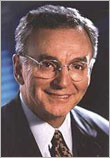|

Remarks

 |
Dr. Joseph Bordogna
Deputy Director
Chief Operating Officer
National Science Foundation
Biography
Remarks
NIH-NSF Bioengineering and Bioinformatics Summer Institutes Program
December 10, 2004
|
Good morning to all of you, and welcome. I am pleased to join you for the NIH-NSF BBSI Grantees Meeting. I want to begin by thanking Drs. Pettigrew, Swaja and Temple-O'Connor for their commitment and efforts in managing the BBSI program.
To our students/grantees I extend a special greeting. I am confident that in the near future, there will be many more following in your footsteps to explore the areas where the living and non-living worlds meet.
This promises to be an exciting and informative gathering. It also denotes another exemplary partnership between NSF and NIH. Both agencies foresee bioengineering and bioinformatics as vital fields that undergird, lift, and point the way for many areas of 21st century science and technology. Our shared goal is to provide a rich interdisciplinary research and education experience for students in these developing fields and to attract people who can work at the junctures between disciplines and organizational boundaries.
The natural evolution of boundary-crossing research and education leads to new kinds of partnerships among agencies. The BBSI program is a great example of collaboration at all levels. The program has sponsored institutes across the country, from Clemson University in South Carolina, to the University of Minnesota, to California State University. These interagency partnerships are particularly fruitful because they blend the strengths of each agency, bringing to the fore what each agency does best.
In that vein, this program brings together people from different backgrounds, with different expertise, different ideas and, importantly, different intellectual and experiential perspectives. And all of you are here to reach the ultimate goal -- building bridges between the physical and life sciences.
BBSI is a bridge in many respects. It forms a bridge for undergraduate seniors to transition to the graduate level. The Summer Institutes Program fills a gap by integrating senior undergraduates more broadly into its program, and easing the transition from undergraduate to graduate level education in fields related to bioengineering and bioinformatics. A strong indicator of its success is that 44% of the students who have participated in the program have either decided to, or are pursuing graduate study in bioengineering and bioinformatics.
The idea of BBSI actually originated with Debbie Crawford and Sohi Rastegar during their monthly commutes to attend BECON meetings at NIH. The initial discussions focused on how to initiate collaboration between the two agencies. And on the NIH side, it was with the thoughtful efforts of Dick Swaja at NIBIB that the collaboration germinated. It was with the commitment of the National Institute of Biomedical Imaging and Bioengineering (NIBIB) that the program finally came to fruition.
Eventually a Working Group was formed to develop the program. So BBSI began from bottom up while having top-down support from both agencies and the academic community.
BBSI has been successful since its inception. The program has had particular success in attracting a diverse student population:
- One hundred and thirty-one students were trained in the nine BBSIs in the Summer of 2004;
- Twenty-eight percent of the students are women;
- Twenty-seven percent of the students are from underrepresented racial and ethnic (minority) groups;
- On average, six different departments are involved in the BBSIs. And, the program has attracted students from many disciplines/departments. Well more than half of the participants are from outside the sponsoring universities. BBSI is a model for how to reach out and find students from unlikely places. It is clearly reaching broadly into the national talent pool.
The BSSI program is also a model for bridging the sciences and engineering. When we think of bridges, we often picture shimmering suspension bridges, spanning huge gulfs of land or water, ferrying people and goods between previously inaccessible lands.
Bridges are complicated -- an amalgamation of steel, concrete and, today, polymers, sensors and smart materials, all meticulously integrated to tolerate dynamic stresses and to endure for decades. These integrated border-crossing societal tools provide new opportunities for society, commerce and industry; bridges open up new frontiers. Their ultimate design manifests our intent for societal interaction. In the end, a good bridge integrates as well as connects; it enables a fresh and holistic view of the parts it joins.
The underpinnings are already in place. As Einstein would say, imagination is now the imperative for creating a research venue that is significantly greater than the sum of its parts.
There are grand opportunities ahead. And BBSI is essential to developing the talent that will enable us to capitalize on them.
It is for students like LaShan Simpson, who attended the BBSI at Clemson; and Margaret Kloster of Western Washington University, who was able to attend the BBSI at Iowa State; and Chuck Lemken of Lafayette College, who was able to attend the BBSI at VCU; and many others that these investments find their true meaning.
Investing in our young is the best kind of investment we can make. You are the future of our country, and we look forward to your contributions to our Nation.
Best wishes for a successful meeting.

Return to a list of Dr. Bordogna's speeches.
|











